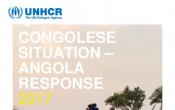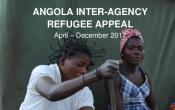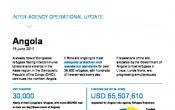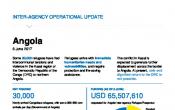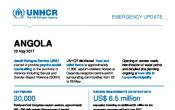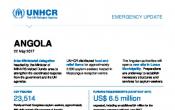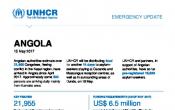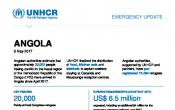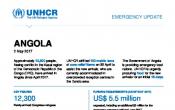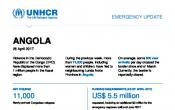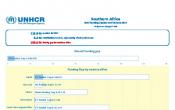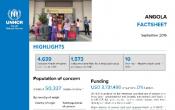Angola
Operation: Angola
Location
{"longitude":18,"latitude":-12,"zoom_level":0}
Latest update of camps and office locations 21 Nov 2016. By clicking on the icons on the map, additional information is displayed.
Key Figures
| 2016 end-year results | |
| 2,600 | people attended workshops on protection and prevention of sexual and gender-based violence |
| 1,300 | people of concern benefitted form legal counselling |
| 164 | children under 1 year old were issued with birth certificates |
| 2017 planning figures | |
| 300 | applicants will be informed on the refugee status determination (RSD) procedure |
| 250 | people of concern with specific needs will receive appropriate support |
| 150 | people of concern will receive legal assistance |
| 50 | people of concern will be assisted with civil status registration or documentation |
Latest Updates
People of Concern
9%
Decrease in
2016
2016
| 2016 | 45,698 |
| 2015 | 50,337 |
| 2014 | 59,970 |

[["Refugees",15555],["Asylum-seekers",30143]]
Loading ...
Angola
< Back
2016
{"categories":[2012,2013,2014,2015,2016,2017],"budget":[9.84500068,4.69733169,5.76081952,5.45305636,3.72148992,36.64218327],"expenditure":[6.14939035,3.58025033,4.43620524,3.08539954,2.06958952,null]}
{"categories":[2012,2013,2014,2015,2016,2017],"p1":[9.84500068,4.69733169,5.76081952,5.45305636,3.72148992,36.64218327],"p2":[null,null,null,null,null,null],"p3":[null,null,null,null,null,null],"p4":[null,null,null,null,null,null]}
{"categories":[2012,2013,2014,2015,2016,2017],"p1":[6.14939035,3.58025033,4.43620524,3.08539954,2.06958952,null],"p2":[null,null,null,null,null,null],"p3":[null,null,null,null,null,null],"p4":[null,null,null,null,null,null]}
Loading ...
CHOOSE A YEAR
- 2015
- 2016
- 2017
Working environment
Angola’s asylum law, enacted in 2015, is yet to be implemented and there is currently no functioning asylum procedure or capacity to undertake refugee status determination. Refugees and asylum-seekers are also vulnerable to detention due to a lack of proper documentation. Furthermore, the suspension of birth registration of foreigners also impacts people of concern to UNHCR.An inter-sectoral technical working group on the cessation of refugee status for refugees from Liberia, Rwanda and Sierra Leone finalized the National Plan of Action for the implementation of the Comprehensive Solutions Strategy. In August 2016, an inter-ministerial commission was established to finalize the planning for the invocation of cessation by early 2018.
Population trends
- Official statistics on refugees and asylum-seekers are only available from 2014, which reported Angola was hosting 15,555 refugees and some 30,000 asylum-seekers.
- The main countries of origin were Côte d’Ivoire, the Democratic Republic of the Congo (DRC), Eritrea, Guinea, Mauritania, Rwanda, Sierra Leone, Somalia and Sudan.
Achievements and impact
- UNHCR was able to submit 10 per cent of refugees identified to be in need for resettlement, despite challenges related to case identification and referrals.
- A protection needs assessment was undertaken for refugees residing in Luanda Province who were recognized between 1995 and 2011, allowing UNHCR to register close to 1,000 people of concern.
Unmet needs
- Refugees do not have access to asylum procedures and refugee status determination.
- The suspension of the issuance of Angolan documentation to former Angolan refugees in neighbouring countries (the DRC and Zambia) has been hampering the local integration of Angolans;
- UNHCR was not able to adequately provide socio-economic assistance to the most vulnerable refugees or promote livelihood activities to foster self-reliance.
Operational context and population trends
Immigration control is gaining prominence on the political agenda in Angola as the country’s expanding economy continues to attract foreign workers.According to data provided by the Service for Migration and Foreigners, housed in the Ministry of the Interior, by the end of 2014:
- 59,905 people of concern to UNHCR are living in Angola, of whom 15,474 are refugees, 30,147 are asylum-seekers and 14,284 are Angolan returnees
- The refugee population in Angola originates mainly from the Democratic Republic of Congo (DRC) Katangese, Rwanda, Sierra Leone, Ivory Coast, Sudan and Somalia. The Government of Angola has been informed about the possible cessation clause for Liberian, Sierra Leonean and Rwandan refugees, but has yet to issue a formal decision on the matter, and an exemption procedure has yet to be established
- The population group of asylum-seekers is comprised of 32 different nationalities.
In 2016, the number of refugees is expected to increase as the national refugee status determination (RSD) body is holding regular sessions and is seeking to reduce the backlog of asylum applications. In spite of the possible cessation clause that may be invoked for Liberians and Sierra Leoneans, the number of refugees may reach up to 20,000.
Key priorities in 2016
UNHCR will continue to support the Government of Angola as its main counterpart by:- Improving of the effectiveness of the national RSD body through training
- Collecting reliable refugee data
- Developing and issuing improved identity documents for asylum-seekers and refugees
- Supporting people of concern with special needs and community self-management
- Capacitating Angolan authorities in developing adequate legislation and policy aimed at establishing a favourable protection environment.

